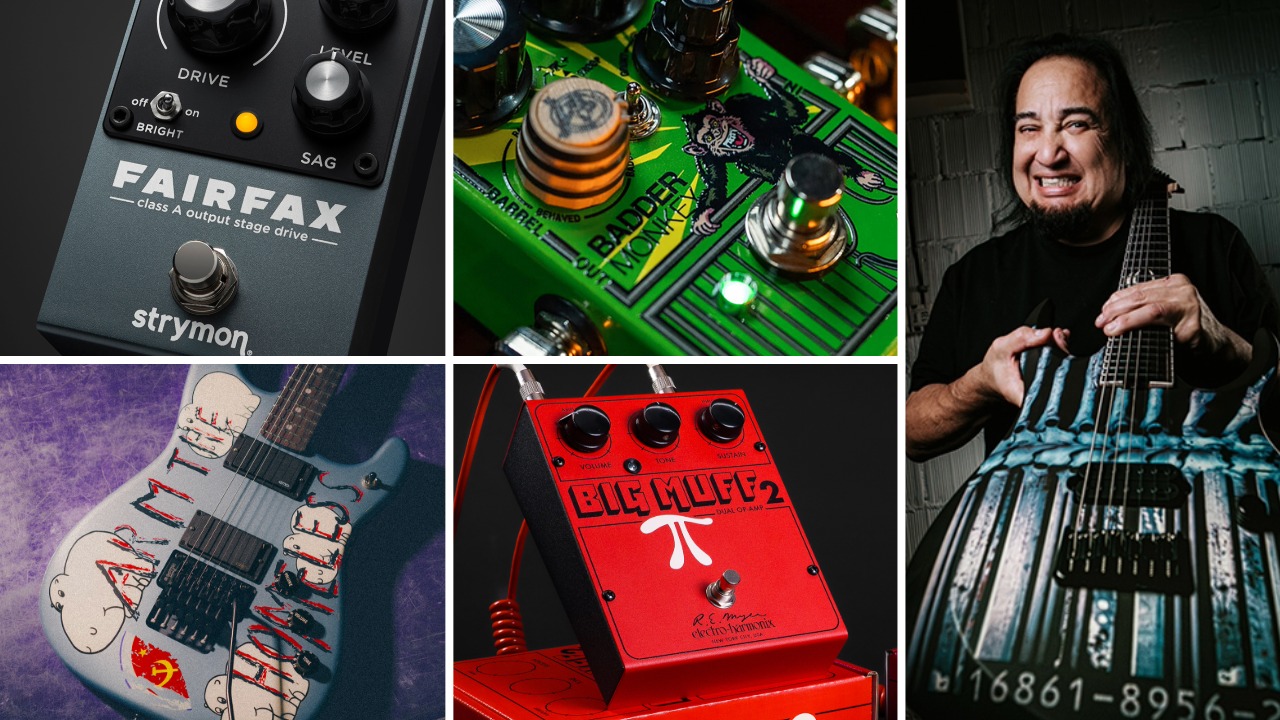The technique secrets of the decade's best guitarists
A rundown of the explosive playing styles of Mark Tremonti, Tosin Abasi, Gary Clark Jr. and Nita Strauss

We recently asked you - our loyal readers - to vote for who you thought were the 20 best guitarists of the decade. What resulted was a truly eclectic round-up of the industry's most prominent six-string masters, including prog gurus John Petrucci and Guthrie Govan, modern-day blues legends Joe Bonamassa and Eric Gales, and metal shredders Synyster Gates and Jason Richardson, to name a few.
And we've decided to take it a step further, diving deep into the techniques and playing styles of your top four - Mark Tremonti, Tosin Abasi, Gary Clark Jr. and Nita Strauss.
Each of the four possess vastly different playing styles and gifts, from Tremonti's ability to nail just about everything - clean intros, pounding riffs and soaring solos - to Abasi's groundbreaking and genre-shaping eight-string mastery.
From Clark Jr.'s storytelling blues leads to Strauss' fretboard dominance, there's a wealth of knowledge to be gained from studying the techniques of these true masters of the guitar.
Mark Tremonti

Alter Bridge’s Mark Tremonti is a true modern guitar hero who not only shreds his ass off with the best of them, but also writes great rock riffs and song parts, from the gentle and elegantly majestic clean-tone intros to such hits and fan favorites as Blackbird, In Loving Memory, Broken Wings and Words Darker Than Their Wings, to the roaring, intense crunch riffs featured in songs like Metalingus and Wouldn’t You Rather.
Tremonti often employs non-standard tunings, mostly drop-D (low to high, D A D G B E) and its down-tuned equivalents, which he has used to craft many of his most powerful riffs, many of which incorporate quickly shifting one-finger power chords, strummed octaves and single-note melodies pitted against a ringing low pedal tone, as in such Alter Bridge songs as Open Your Eyes and Isolation.
The guitarist’s collaborative writing efforts with vocalist and guitarist Myles Kennedy have proven time and again to be very successful and prolific, and the latest Alter Bridge album, Walk the Sky, features lots of well-written songs, such as Dying Light and Take the Crown.
All the latest guitar news, interviews, lessons, reviews, deals and more, direct to your inbox!
Tremonti is an accomplished guitarist, especially in regard to his fast, clean alternate picking and refined string bending and vibrato techniques, which are hallmarks of his exciting lead style.
When crafting his solos, Tremonti consistently strikes a tasteful balance between melody and flash, and his leads often bring to mind the soulful wailing of Slash and Jimmy Page and the ripping metal intensity of Dimebag Darrell and Zakk Wylde.
The overdriven, bridge-humbucker-pickup tones that Tremonti dials in on his signature PRS SE guitar and MT 15 tube amps, for both his lead and heavy rhythm playing, are nicely balanced between a modern-metal djent edginess and a more traditional hard-rock fatness and crunch.
Tosin Abasi

Like Allan Holdsworth, Tosin Abasi is a true technical and creative guitar genius whose pioneering musical vision looks and ventures far beyond where most other players can see, hear or play.
Armed with an Abasi eight-string electric guitar, which sports a low B string plus an octave-lower bass E, the Animals as Leaders founder and primary songwriter, whose style is rooted in progressive metal, embraces an inventively eclectic and sophisticated approach to composing that draws elements from other genres, such as jazz, funk and hip-hop.
Tosin has obviously put in the time to study, at a conservatory level, advanced guitar playing techniques, scales, arpeggios, intervals and chord voicings all over the fretboard, as well as music theory, and his mastery of his instrument and ability to control it - not to mention his musical inventions and arrangements - reflect all that, but never gratuitously.
Tosin’s playing and composing are inspired and inspiring to his peers, and his music reminds listeners, in an appealingly original and enlightening way, of what is possible, and that things like minor 9 and major 7#11 chords can be used tastefully in a prog metal context.
Like jazz pianist Herbie Hancock, Abasi makes brilliant use of his instrument’s extended range to voice chords in interesting ways, combining upper-register tonal clusters with wide intervals between lower chord tones. And his keen sense of rhythm and penchant for writing riffs in unusual meters, such as 7/8, reflect a clever and sophisticated compositional approach.
Tosin’s lead playing is highly inventive and appealing, often characterized by an aggressive yet fluid touch and technical flair, coupled with sensitivity and soulfulness. His solos bring to mind the wailing of Holdsworth and John Petrucci.
Abasi’s grasp of tone production and wide-ranging palette of timbres, ranging from pristine clean to super-saturated distortion with singing sustain, offer inspiration and guidance to players of all stripes.
Gary Clark Jr.

Steeped in the great blues-rock tradition of fat-sounding electric guitar tone and earthy, minor-pentatonic based riffs and soulful grooves, Gary Clark Jr.’s playing and songwriting offer the guitar community and rock world an important and welcomed breath of musical fresh air, in an age of increasingly processed-sounding rock music.
Songs like When My Train Pulls In and Bright Lights, while technically simple, in terms of harmonic structure and chord changes, offer Clark an open canvas upon which to express himself and build captivating, passionate and at times psychedelic guitar solos that bring to mind Jimi Hendrix’s inspired, open-ended improvisations on such rock classics as Who Knows and Voodoo Child (Slight Return).
Clark is also a socially conscious artist who isn’t afraid to use his music to express his feelings about troubling issues like racism that still pervade modern American society.
With songs like This Land, he has managed to effectively weaponize his guitar and voice and use them to enlighten listeners to serious issues, in a way that warms their hearts, similar to how a gospel choir can inspire a church congregation beyond what a preacher’s words can do.
While not a technical shredder, Gary’s guitar style is highly polished and musical, when it comes to things like string bending and vibrato, which recall the distinctively vocal-like lead guitar voices of Hendrix and Mountain man Leslie West.
Clark’s playing is also noteworthy for his tonal sensitivity, nuanced touch, sense of dynamics and commanding mastery of the lost art of backing off the guitar’s volume control, in order to let it breathe.
Nita Strauss

Until recently best known as touring lead guitarist for Alice Cooper and her previous stint with the Iron Maidens, Nita Strauss has, with the release of her 2018 solo album, Controlled Chaos, which features the virtuosic shred instrumentals Pandemonium, Mariana Trench and The Quest, established herself as one of the most celebrated metal guitarists and shredders on the world stage.
The highly talented young axe slinger has obviously put in the time and effort to learn how to manipulate and control her instrument and develop her musicianship to a level approaching that of Steve Vai, Joe Satriani, Yngwie Malmsteen, Randy Rhoads and John Petrucci.
Strauss’s lead playing tastefully showcases her disciplined mastery of several essential areas of rock lead guitar study, such as scales and modes and their overlapping three-notes-per string patterns, which she commandingly uses to create fluid legato licks and fierce alternate-picked runs all over the fretboard.
Strauss is also well-versed in arpeggios, which she employs for neoclassical-flavored sweeps and slinky Van Halen-esque tapping passages, and palm muting and noise suppression, as evidenced in her clean, precise execution of classically flavored melodic inventions.
Strauss’s rhythm playing is rock-solid, too, and you can hear her embrace of stylistic elements from several generations and genres, from modern metal chugging and pinch harmonic squeals to ringing open chords and arpeggiated figures rooted in classic rock.
Over the past 30 years, Jimmy Brown has built a reputation as one of the world's finest music educators, through his work as a transcriber and Senior Music Editor for Guitar World magazine and Lessons Editor for its sister publication, Guitar Player. In addition to these roles, Jimmy is also a busy working musician, performing regularly in the greater New York City area. Jimmy earned a Bachelor of Music degree in Jazz Studies and Performance and Music Management from William Paterson University in 1989. He is also an experienced private guitar teacher and an accomplished writer.

